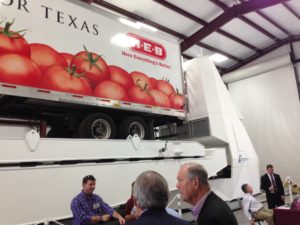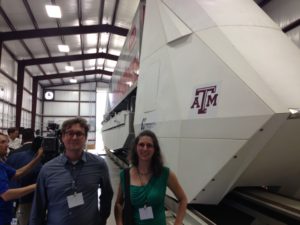 On September 9th, Adrian Shelley and I went to Bryan, Texas, to watch the unveiling of the Freight Shuttle System (FSS), a technology currently being built and tested by Freight Shuttle International. Dr. Stephen Roop, chief scientist at Freight Shuttle International and a professor at the Texas A&M Transportation Institute, opened the unveiling with a press briefing sharing his vision. The FSS is an electric, autonomous shuttle powered by a linear induction motor, providing low friction to the steel wheels running on steel lines, similar to train tracks. The FSS combines elements of truck and train transport – single shuttles run on a track similar to a train track, and according to Dr. Roop’s vision, those tracks would be elevated from other modes of transportation to reduce congestion, provide a strong level of predictability and non-stop service, and reduce infrastructure damage often associated with truck transportation.
On September 9th, Adrian Shelley and I went to Bryan, Texas, to watch the unveiling of the Freight Shuttle System (FSS), a technology currently being built and tested by Freight Shuttle International. Dr. Stephen Roop, chief scientist at Freight Shuttle International and a professor at the Texas A&M Transportation Institute, opened the unveiling with a press briefing sharing his vision. The FSS is an electric, autonomous shuttle powered by a linear induction motor, providing low friction to the steel wheels running on steel lines, similar to train tracks. The FSS combines elements of truck and train transport – single shuttles run on a track similar to a train track, and according to Dr. Roop’s vision, those tracks would be elevated from other modes of transportation to reduce congestion, provide a strong level of predictability and non-stop service, and reduce infrastructure damage often associated with truck transportation.
Dr. Roop noted the emissions of the FSS are tied to the source of power. What that means is that the FSS itself would generate no point-of-source pollution like the cancer-causing pollution created by diesel engines currently on the road. Furthermore, because the FSS would operate under DC voltage, it could be tied easily to renewable energy. In that way, the FSS could take advantage of the increasing access to renewable energy in Texas and potentially be net zero in terms of carbon pollution.
The FSS is not designed to transport hazardous or toxic materials, and although it could possibly be used to transport people, it is intended now to be separate from people – that is to be contained within a separate line so that the roads and highways can be used for people, not cargo.
The Port of Houston Authority signed a memorandum of understanding with Freight Shuttle International and is planning to use the FSS to transport cargo between its container terminals, Bayport and Barbour’s Cut. Freight Shuttle International stated that the FSS line could be operational within 3 years.



